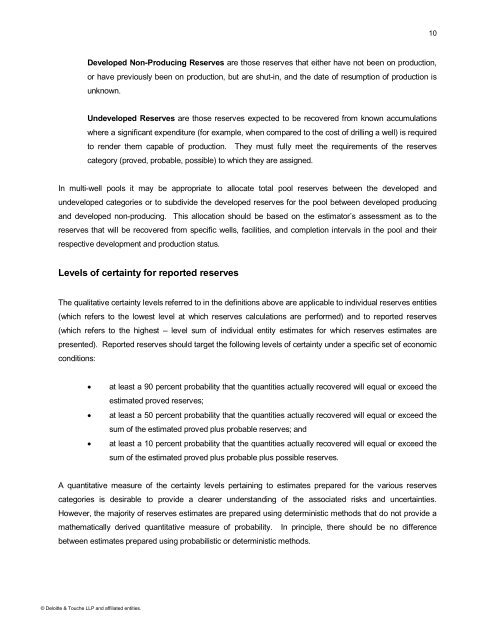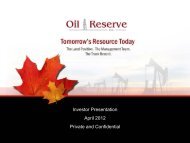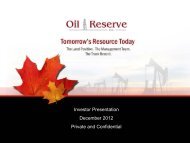Athabasca Viking/Grand Rapids/Nisku Technical ... - Oil Reserve Inc.
Athabasca Viking/Grand Rapids/Nisku Technical ... - Oil Reserve Inc.
Athabasca Viking/Grand Rapids/Nisku Technical ... - Oil Reserve Inc.
Create successful ePaper yourself
Turn your PDF publications into a flip-book with our unique Google optimized e-Paper software.
10<br />
Developed Non-Producing <strong>Reserve</strong>s are those reserves that either have not been on production,<br />
or have previously been on production, but are shut-in, and the date of resumption of production is<br />
unknown.<br />
Undeveloped <strong>Reserve</strong>s are those reserves expected to be recovered from known accumulations<br />
where a significant expenditure (for example, when compared to the cost of drilling a well) is required<br />
to render them capable of production. They must fully meet the requirements of the reserves<br />
category (proved, probable, possible) to which they are assigned.<br />
In multi-well pools it may be appropriate to allocate total pool reserves between the developed and<br />
undeveloped categories or to subdivide the developed reserves for the pool between developed producing<br />
and developed non-producing. This allocation should be based on the estimator’s assessment as to the<br />
reserves that will be recovered from specific wells, facilities, and completion intervals in the pool and their<br />
respective development and production status.<br />
Levels of certainty for reported reserves<br />
The qualitative certainty levels referred to in the definitions above are applicable to individual reserves entities<br />
(which refers to the lowest level at which reserves calculations are performed) and to reported reserves<br />
(which refers to the highest – level sum of individual entity estimates for which reserves estimates are<br />
presented). Reported reserves should target the following levels of certainty under a specific set of economic<br />
conditions:<br />
<br />
<br />
<br />
at least a 90 percent probability that the quantities actually recovered will equal or exceed the<br />
estimated proved reserves;<br />
at least a 50 percent probability that the quantities actually recovered will equal or exceed the<br />
sum of the estimated proved plus probable reserves; and<br />
at least a 10 percent probability that the quantities actually recovered will equal or exceed the<br />
sum of the estimated proved plus probable plus possible reserves.<br />
A quantitative measure of the certainty levels pertaining to estimates prepared for the various reserves<br />
categories is desirable to provide a clearer understanding of the associated risks and uncertainties.<br />
However, the majority of reserves estimates are prepared using deterministic methods that do not provide a<br />
mathematically derived quantitative measure of probability. In principle, there should be no difference<br />
between estimates prepared using probabilistic or deterministic methods.<br />
© Deloitte & Touche LLP and affiliated entities.




